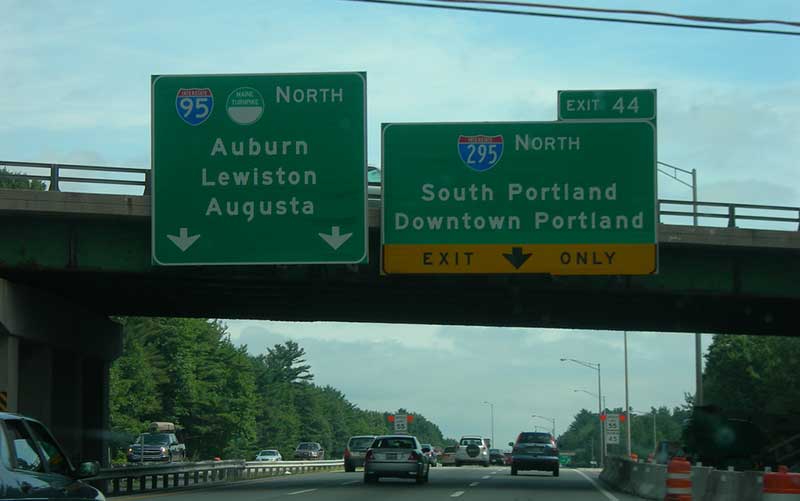
Traffic is getting worse in the greater Portland area but are more Turnpike lanes really the answer? Photo: Jimmy Emerson, DVM via CC2.0
If you’ve spent any time driving in the greater Portland area in recent years, then you know that traffic congestion around here is getting worse. It’s especially heavy along the Maine Turnpike stretch from Portland to Falmouth, as well as for commuters trying to access the greater Portland area from the burgeoning suburbs of Westbrook, Scarborough, and Gorham.
In response to this growing problem, the Maine Turnpike Authority wants to build a new six-lane highway running to and from those western suburbs. It also wants to expand the Turnpike between Portland and Falmouth from four lanes to six.
While we at CLF hate sitting in traffic as much as the next commuter – not just for the time it wastes, but also for the air and carbon pollution traffic jams it creates – we also know that new and wider roads are not always the best solution. So we are going to make sure that before the Turnpike Authority starts paving, it thoroughly evaluate all reasonable alternatives to expansion, including programs and policies that encourage people to drive less and increased public transit, bicycle, and pedestrian options. We believe that reviewing all of these options will help identify solutions that both benefit commuters while lowering the climate-damaging pollution generated by the vehicles we drive.
A New East-West Highway
Drivers heading into and out of the greater Portland area from the western suburbs have been dealing with increased traffic congestion for several years. In 2012, after completing a feasibility study to assess traffic in this corridor as well as possible solutions, the Turnpike Authority and state Department of Transportation concluded that additional highway capacity was the answer. They proposed a new highway running approximately six to eight miles from Portland to Gorham, along with additional bypasses and lanes. The study also recommended a “coordinated implementation” of the project, which includes land-use strategies, such as designating areas for future residential development with higher population densities and increased access to transit, and public transit improvements.
Assessing the Alternatives and Avoiding a Roads-Only Approach
This spring, the Turnpike Authority sought legislative authorization to construct this so-called “connector” highway. CLF testified at the public hearing on the bill, emphasizing that, under the state’s Sensible Transportation Policy Act, the Turnpike Authority is required to assess the full range of reasonable transportation alternatives before building new highway infrastructure. We also reminded the Turnpike Authority that it has committed to pursuing a coordinated implementation, and we highlighted the importance of public involvement in the planning process.
But surely a new connector highway would solve the traffic problem? Not necessarily. Studies have clearly established that building more roads or lanes alone does not alleviate congestion. That’s why we are advocating for a comprehensive strategy, rather than a roads-only approach, to the east-west congestion problem. Now that the bill authorizing the connector highway is law, CLF will continue to monitor this project and ensure that Turnpike Authority satisfies its legal obligations.
New North-South Lanes on the Turnpike
The Turnpike Authority is also exploring adding a lane in each direction of the eight-mile stretch of highway between Exit 44 (Portland) and Exit 52 (Falmouth) to ease congestion and address safety issues. It has launched a targeted needs assessment for this “Portland Mainline” expansion, which it plans to complete by early 2018. As part of this assessment, the Turnpike Authority has convened a Planning Advisory Committee (PAC), consisting of 19 entities, and has held two of four planned committee meetings to date.
Avoiding Additional Vehicle Emissions and Mitigating Climate Change
CLF is actively participating in the Advisory Committee meetings. We are pushing for a full evaluation of alternatives to the lane expansion and the avoidance of climate-changing vehicle emissions. At the first meeting, we urged the Turnpike Authority to expand its public outreach to raise awareness about the proposed expansion and to solicit more feedback from potentially impacted communities.
CLF also urged the Turnpike Authority to consider alternatives to lane expansion, including transportation demand management (programs and policies that encourage people to drive less) and increased public transit, bicycle, and pedestrian options. Climate change poses real and immediate risks here in Maine, and the transportation sector, including commercial and passenger vehicles, accounts for 54% of Maine’s greenhouse gas emissions. Looking at ways to put fewer cars on the road in the first place would help our climate and our traffic congestion.
Last month, CLF participated in the second advisory committee meeting, at which the Turnpike Authority indicated that it does not have the authority to implement a full range of alternatives. We urged the agency to continue to assess all reasonable transportation alternatives, even those it cannot implement, including bicycle and pedestrian options. CLF also reminded the Turnpike Authority that under the Sensible Transportation Policy Act, it must give preference to reasonable transportation alternatives before expanding the highway.
Promoting Transit and Other Alternatives to Highway Expansions
CLF is continuing to monitor each of these proposed highway expansions, and actively participating in the planning process for both. We are part of a group that is assessing various transit initiatives and projects in and around Portland, including the expansion of bus service into Westbrook, Scarborough, and Gorham, which would help alleviate the congestion problems the MTA seeks to resolve through building more highways.
There’s no question that, with transportation being such a significant part of our state’s carbon pollution, we must take collective action now to cut our emissions. Less pollution from our cars, SUVs, and trucks will not only help our climate, however; it will also improve our health and quality of life. But simply adding lanes and roads is not the answer. In fact, that could make our pollution problems worse. It’s time for us to use our collective creativity to develop new solutions to this problem.



